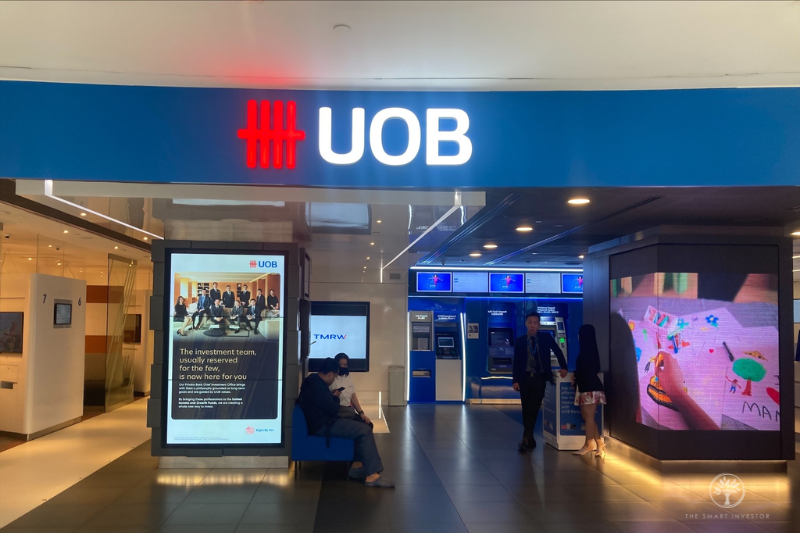UOB’s Core Net Profit Rises to S$1.48 Billion: 5 Highlights from the Bank’s Latest Business Update

United Overseas Bank (SGX: U11), or UOB, is the first bank to report its earnings for 2023’s final earnings season.
The lender released its third quarter 2023 (3Q 2023) business performance highlights that saw a creditable performance.
CEO Wee Ee Cheong warned that the macroeconomic environment could “remain bumpy” but the ASEAN region should stay resilient.
He also believes that the bank’s robust portfolio and strong balance sheet should see it through these headwinds.
Here are five key highlights from the bank’s latest business update.
1. A slight increase in core net profit
UOB’s net interest income rose 9% year on year to S$2.4 billion but remained flat quarter-on-quarter.
Fee income grew 14% year on year to S$591 million and helped total income to improve by 9% year on year to S$3.5 billion.
With total expenses rising by just 4% year on year, the lender saw its 3Q 2023 operating profit jump 12% year on year to S$2 billion.
That said, the bank’s net profit dipped by 1% year on year to S$1.38 billion due to one-off expenses for integrating the Citigroup (NYSE: C) acquisition.
Excluding this one-off expense, core net profit would have increased by 5% year on year to S$1.48 billion.
For the first nine months of 2023 (9M 2023), UOB’s total income climbed 28% year on year to S$10.5 billion on the back of a 26% year-on-year rise in net interest income to S$7.3 billion.
Core net profit for 9M 2023 jumped 33% year on year to S$4.6 billion.
2. Fee income near an all-time high
The bank’s fee income for 3Q 2023 came close to an all-time high, powered by loan-related and credit card fees.
Credit card fees nearly doubled year on year to S$104 million and hit a new record as consumer sentiment remained buoyant.
Loan-related fees saw a rebound, rising by 5.5% year on year to S$269 million.
Wealth management fees also rose 11.5% year on year to S$146 million although investor sentiment remained cautious.
UOB’s assets under management jumped 21% year on year to hit S$170 billion, of which nearly six in 10 of these customers are from outside Singapore.
3. Net interest margin and loan book declined slightly
Moving on to the net interest margin (NIM).
UOB’s NIM for 3Q 2023 rose 0.14 percentage points year on year from 1.95% to 2.09%, in line with overall higher global interest rates.
The blue-chip lender’s NIM, however, has been on a steady decline since peaking at 2.22% in 4Q 2022.
The reason given was excess liquidity with the bank needing to pay out a better deposit rate on these customer savings, thereby putting pressure on its NIM.
UOB’s loan book saw a 2% year on year decline to S$318 billion, led by a 13% year-on-year fall in gross loans in Indonesia and a 6% year-on-year dip for Singapore loans.
Weaker foreign exchange rates played a role in this dip.
At constant currency, UOB would have seen flat year on year loan growth.
4. Stable non-performing loans ratio
The lender’s total loan provision stood at S$151 million for 3Q 2023, up slightly from the S$135 million a year ago.
UOB wrote back some of its pre-emptive general allowance for the quarter and brought its credit costs down to 0.19%.
This was an improvement from the previous quarter’s 0.26% credit cost but still slightly above 3Q 2022’s credit cost of 0.16%.
The bank’s non-performing loans (NPL) ratio came in at 1.6% for the quarter, stable quarter-on-quarter but a touch higher than 3Q 2022’s 1.5%.
With expenses keeping pace with income growth, UOB’s cost-to-income ratio (CIR) excluding the Citigroup acquisition stood at 41% for 3Q 2023.
This level of CIR is an improvement over the prior year’s 42.6% and is in line with the previous quarter’s 40.9%.
5. A sanguine outlook
Despite the macroeconomic headwinds, UOB had a sanguine outlook for 2024.
The local bank expects mid-single-digit year on year loan growth with NIM to remain at current levels, buoyed by the US Federal Reserve’s proclamation that rates may have to stay “higher for longer”.
The bank also expects fee income to grow by double-digits year on year.
Meanwhile, its Citigroup integration is on track.
The lender has already migrated close to 700,000 ex-Citi customers onto the UOB platform.
For Indonesia, Thailand and Vietnam, the integration is proceeding as planned.
By the time your child grows up, inflation will have gobbled up their savings. If you not only want to protect their money but also grow it, there are 3 SGX stocks you can consider buying. One has already proven to give a 55.8% dividend pay rise. Get all the details in our latest special FREE report. Just click here.
Disclosure: Royston Yang does not own shares in any of the companies mentioned.
The post UOB’s Core Net Profit Rises to S$1.48 Billion: 5 Highlights from the Bank’s Latest Business Update appeared first on The Smart Investor.

 Yahoo Finance
Yahoo Finance 